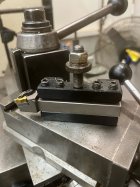Dusty Stevens
Shiner
The thing i like about chickenserts is once the tool touches the crest of the thread youre doneSo to channel @Dusty Stevens, would those be called "chicken inserts"?
The thing i like about chickenserts is once the tool touches the crest of the thread youre doneSo to channel @Dusty Stevens, would those be called "chicken inserts"?
The thing i like about chickenserts is once the tool touches the crest of the thread youre done
There are soooo many ways to do things. Today I showed the kid who will be running the second lathe how to thread a muzzle. He asked too many of the wrong kind of questions. You know, "why not do it this way" when it's six of one and a half dozen of the other, then arguing when you tell him.
I finally told him that as long as he met spec, it looked good, and he didn't crash the lathe; that he could do it any way he wants..........

If those are the wrong kind of questions, then it's a teaching problem, not a learning one."why not do it this way"
If those are the wrong kind of questions, then it's a teaching problem, not a learning one.
There's nothing worse than someone who blindly believes and follows what he was told for the next 40yrs without ever questioning whether it was the best or even right way to begin with.
My HOW question is. . . . . How did someone with that level of knowledge get a job in a workshop building high end custom rifles?


Here is one I did today. A dial indicator with a mighty mag holder tells me when to cut out the half nut and back off the cross slide.
I like to leave as much meat around the chamber as possible. No relief grooves for me. And if I need to set the barrel back down the road, the job looks seamless.
TMX. I had a bison on the previous one. Both are quality chucks.
Bat doesnt tell you to cut a relief groove. They say to cut full thread depth to within .100 of the shoulderI noticed early on that with an 18 TPI BAT SV or BAT B, it was hard to get the action the thread on all the way to the shoulder when threading all the way to the shoulder.
The BAT SV was the first action I threaded for, and the B was next. I avoided cutting a relief groove, but then I would always have to come back and cut away some of the threads. The challenge of course was cutting back the threads at the shoulder without rolling the last thread I wanted to keep.
I found a very sharply angled insert and that helped. Better than that was to come back with a parting tool and cut away the threads with that. However, the best practice was just to cut a relief groove before threading--like BAT tells you to do.
With the 16 TPI threads on a BAT M, no relief groove is needed unless you have to cut the shoulder back a turn to time the muzzle to up.
For actions with a sandwiched recoil lug, no relief groove is needed. Also, it's good to leave .125" or so of full diameter unthreaded, tenon depending on lug width, to support an align the lug.
You can look at an action and tell how much if any relief groove is helpful. So far I have threaded and chambered BAT SV, B, M, Igniter long and short, Vesper; New M-70 (CRF), Rem 700, Christensen, RBROS, Terminus Zeus and Kratos Lite, Howa, and Tikka. That covers M26 1.5, 28 TPI, 18 TPI, and 16 TPI.
As to muzzles I have threaded 36 TPI, 32 TPI, 28 TPI, and 24 TPI.
The best practice is different for each. In general, a relief groove works very well for everything but sandwiched recoil lugs. As to the concern about setting back a barrel, if you must do it, there is no issue setting a barrel back one turn even if it has a relief groove.
I guess we all figure out the way they works best for us.....

Bat doesnt tell you to cut a relief groove. They say to cut full thread depth to within .100 of the shoulderView attachment 1396184

